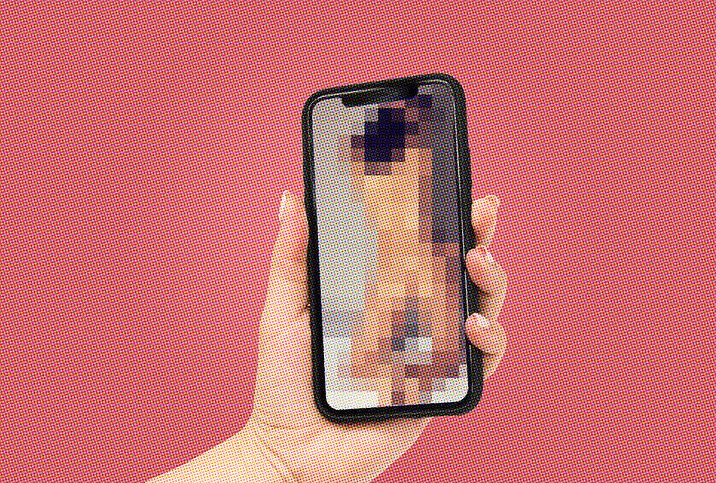Behind Social Media's 'Female Nipple' Ban

The term censorship and its subsequent action typically involve a body or person "shielding" others from what they deem obscene, threatening or endangering. For some reason, nipples—specifically those perceived as "female"—consistently fall under the category of "obscene."
Instagram's Community Guidelines explicitly ban female nipples, except under circumstances such as breastfeeding or "health-related situations (for example, post-mastectomy, breast cancer awareness or gender confirmation surgery) or an act of protest." However, there is no matching ban on male nipples. Similar to Instagram, Tumblr's Community Guidelines don't allow "female-presenting nipples," which is a confusing and verbose way of trying to sound inclusive while still perpetuating sexualization.
As conversations about gender expand, social media guidelines (and who gets to decide what gender a nipple belongs to) become obsolete. By showing up-close images, the Instagram account Genderless Nipples perfectly encapsulates that you can't truly determine who or what gender a nipple belongs to, and therefore, you can't police images of them online.
The problem with gendering
Clare Bayley, founder of the Nectarine Project, an organization devoted to challenging sexual censorship through research and lobbying to improve government and company policies, attributed widening conversations around gender identity as part of the impetus for censorship guidelines to progress away from the gender binary.
"Conversations around gender identities are already the biggest thing currently challenging nipple censorship," Bayley said. "It's impossible to define the double-nipple-standard without using the gender binary, and tech companies are jumping through increasingly awkward linguistic hoops to avoid pushback from their LGBTQ+ audience and employees."
Nora Pelizzari, director of communications at the National Coalition Against Censorship (NCAC), said, "We cannot allow corporations, much less the AI [artificial intelligence] they rely on, to determine gender."
Researcher Os Keyes wrote about automated gender recognition (AGR) and how big tech companies such as Amazon use it: "AGR looks at your bone structure, skin texture and facial shape to prescribe a binary gender."
The problem? You can't detect gender 100 percent from facial features, and this system completely fails trans and nonbinary individuals.
In a shirtless Instagram video, gender nonconforming model and activist Rain Dove called on Instagram to rethink censorship of "female nipples" because it reinforces the sexualization and shame marginalized people already experience. Dove, who showed their DD-cup chest in the video, said that you can't censor their nipples as "male" or "female" because they identify as neither.
How does online censorship perpetuate sexualization?
"No matter how small or flat a woman's chest is, it's seen as sexual—and no matter how large or curvaceous a man's chest is, it's seen as not sexual and, thus, not threatening," Bayley explained.
Censorship of female nipples automatically prescribes their attachment to women as salacious. American artist and feminist activist Emma Shapiro's activism against censorship stemmed from this very mindset, which resulted in the censorship of her art.
"I'm not going to be treated equally as an artist until my body is treated equally in society," said Shapiro, who is based in Valencia, Spain.
'It would be different if we were the ones allowed to value our own bodies' worth and choose how we want to use them.'
In turn, she refuses to accept the premise that she's doing something wrong.
"When censorship happens to you, it feels personal," Shapiro added.
To Shapiro, censorship perpetuates the sexualization of women because censorship is tied to the economy of women's bodies. That is, "limiting access to something makes it more valuable," Shapiro said.
"The true issue here is over who is controlling this," Shapiro continued. "It would be different if we were the ones allowed to value our own bodies' worth and choose how we want to use them, but that is not the case on social media. By censoring our bodies without our consent, we are stripped of our body autonomy—our right to choose what our own bodies mean."
Who does censorship hurt?
Censorship in any form always hurts the most vulnerable. A survey by Salty revealed LGBTQIA+ folks and women of color were more likely to experience censorship on Instagram. Plus-sized profiles were often flagged for sexual solicitation. And it's no surprise that the most common reason for a disabled account was for violating community guidelines.
"This is particularly notable because the promise of social media is a democratization of communication," Pelizzari said. "Social media promises to remove the gatekeepers to public speaking, to allow people all around the world with shared interests to connect with one another, and to give people who feel isolated greater voice and connection."
Social media "deplatforms" black people, larger-bodied people, nonbinary people, kinky people and sex workers, Bayley noted.
"It's not just removing content," Bayley said. "Remember, if you get dinged enough for breaking the rules, you can lose privileges, features, even have your entire account taken away, even if that person's business is run through social media."
Free the Nipple in the online world
It's been years since the Free the Nipple movement garnered notoriety, with other genders asking for the same right that men have: to be topless in public spaces. The movement hasn't evaporated but has instead dispersed into more niche areas of focus, such as online censorship.
Pelizzari explained that the NCAC's We the Nipple campaign was directly influenced by the Free the Nipple movement. Through the campaign, it became evident censorship of female nipples makes it more difficult for health advocates to share pertinent information about breast cancer and also for people seeking to talk about varying gender identities. NCAC campaigns for social media companies to update community guidelines and prioritize freedom of expression.
The movement has instead dispersed into more niche areas of focus, such as online censorship.
As Shapiro explained, although Free the Nipple has become more decentralized, it has inspired people to respond to and protest censorship through the lenses of gender equality, women's health, anti-censorship, artists' rights, LGBTQIA+, performing arts, athletics and more.
"The list goes on because it is quite an intersectional cause," Shapiro said.
"Groups in the past that have successfully pushed back on the policy are breast cancer survivors, trans folk who have top surgery and breastfeeding moms," Bayley added. "Each of those groups has led campaigns to get exceptions made to the nipple policy for their specific interest."
Instagram, specifically, is a mecca for artists to post their photography and art.
"When we are censored by this community by displaying intention and autonomy, it becomes clear that our bodies only can exist on these platforms if we conform to our own objectification," Shapiro said.
"Imposed limits on what can be shown tell the viewer that the limited content is somehow dangerous," Pelizzari added.


















